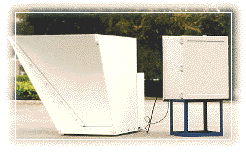INTRODUCTION
Siting
Wind Turbines
Remote Sensing
OVER SEA
Scatterometry
Satellites
Research Programs
OVER LAND
Doppler Radar
U.S. Radar Coverage
Research Programs
ON SITE
Mini-
SODAR
Research Programs
WIND POWER
Growth
in Wind Energy
Finding Strong Winds
Wind Atlases
Site Studies
Web site created
by
Paul Kelly
Graduate Student
Geo Information Science
Department of Geography
Salem State College
Salem, Massachusetts, USA.
E-mail comments and suggestions to pmkelly@prodigy.net.
Last updated 4/24/2002.
|
|
ON SITE
Mini-SODAR
SODAR (SOund Detecting And Ranging or SOund Doppler Accoustic Radar) uses short bursts of high
frequency sound waves in a manner analogous to Doppler radar. Small-scale
air turbulence associated with small temperature differentials (at the
size of the signal wavelength) will return weak but detectable
backscatter. Movement is detectable by Dopper processing, allowing
determination of the wind speed in the radial direction of the receiving
antenna. In order to estimate the wind speed in three dimensions, three
antennae are used, one of which is oriented vertically, the other two of
which are offset sufficiently to solve for movement in the two horizontal
dimensions.
SODAR is limited by several factors: the attenuation
of sound over distance, environmental noise at the received frequencies,
and precipitation, which yields a higher backscatter signal. It can
return estimates of wind speed and direction for every 5 m of height over
its vertical range.
Mini-SODAR deploys the SODAR technology in a small, transportable system,
approximately 1.2 x 1.2 m. Its vertical range is lower than larger SODAR
systems, usually 20 to 200 m rather than 50 to 500 m. the published
specifications on
AeroVironment's Model 4000 mini-SODAR are,
 Maximum
Altitude: 200 meters Maximum
Altitude: 200 meters
Minimum Altitude: 15 meters
Height Resolution: 5 meters
Transmit Frequency (approximate): 4500 Hz
Averaging Interval: 1 to 60 minutes (variable)
Wind Speed Range: 0 to 45 meters/second
Wind Speed Accuracy: < 0.5 meters/second
Wind Direction Accuracy: +/- 5 degrees
Weight: 255 lbs (116 kg)
Antenna Height: 4 ft (1.2 m)
Antenna Width: 4 ft (1.2 m)
Antenna Length: 5 ft (1.5 m)
A
list of mini-SODAR
manufacturers is available on the ISARS web site.
Research Programs
SODAR experimentation and development goes back about
25 years. SODAR is currently used to detect shear winds at airports,
conduct noise propagation studies, and monitor fire, air pollution, and the passage of frontal
systems. It is being evaluated for application to wind turbine
siting.
ISARS (International
Society for Acoustic Remote Sensing of the Atmosphere and Oceans), an informal association of scientists working on
SODAR, organizes
an annual conference to share research results.
In 1999, Ecofys Energy and Environment conducted a 3-month
study to
determine the suitability of mini-SODAR for wind energy siting  . Conducted
at ECN’s wind turbine test site in the Netherlands, the study found that
SODAR-estimated wind speeds were approximately 4 percent less than
anemometer data (after filtering of data contaminated by rain noise and
the operation of a nearby wind turbine). The study identified a need to
establish appropriate settings for signal-to-noise filtering and noted
that, while mini-SODAR could be obtained “off-the-shelf,” data analysis
and interpretation required significant time and understanding of the
technology. . Conducted
at ECN’s wind turbine test site in the Netherlands, the study found that
SODAR-estimated wind speeds were approximately 4 percent less than
anemometer data (after filtering of data contaminated by rain noise and
the operation of a nearby wind turbine). The study identified a need to
establish appropriate settings for signal-to-noise filtering and noted
that, while mini-SODAR could be obtained “off-the-shelf,” data analysis
and interpretation required significant time and understanding of the
technology.
A paper published earlier this year
compared mini-SODAR to anemometer data from KNMI’s 213 m mast in Cabauw,
Netherlands. It found that mini-SODAR-reported wind speeds varied from
the mast’s anemometer by +1 to –1.5 m/s. The same paper projects
comparative costs for mini-SODAR and construction of a mast for anemometer
readings. It estimates that mini-SODAR becomes more cost-effective once
mast heights reach 80 m or more. It is noted that three years ago, wind
turbines were typically 60 m high. Today they are often 120 m. The
breakeven point will be even less if the evaluation site is off-shore,
where mast construction costs are significantly higher. “SODAR: een
doorbraak in kosten en vergunningprocedure?”  is available in Dutch.
is available in Dutch.
While accuracy is a key
concern for site evaluation, the cost comparison may make mini-SODAR the
technology of choice as turbine heights increase—especially for off-shore
locations.
Continue
Top of Page |
 Maximum
Altitude: 200 meters
Maximum
Altitude: 200 meters